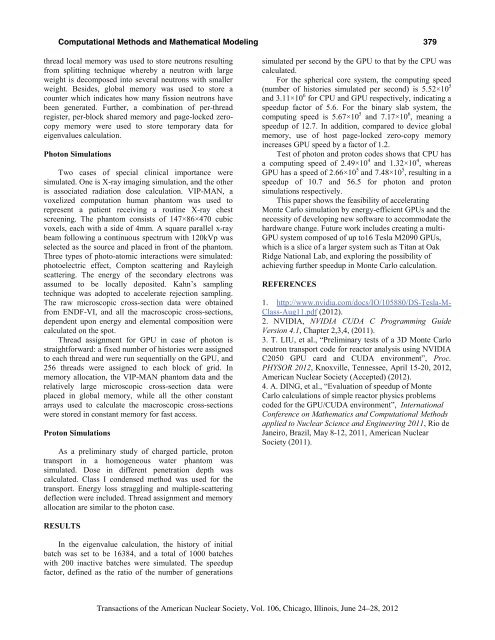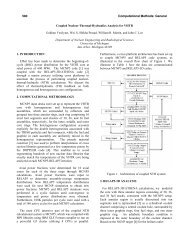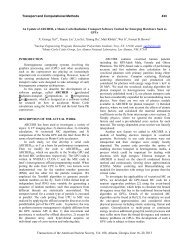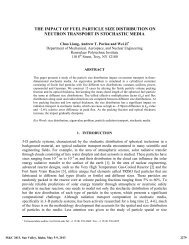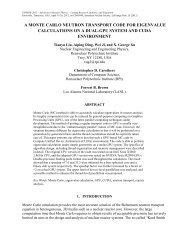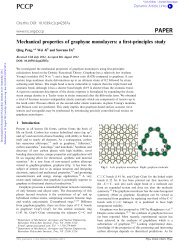GPU/CUDA-Ready Parallel Monte Carlo Codes for Reactor Analysis ...
GPU/CUDA-Ready Parallel Monte Carlo Codes for Reactor Analysis ...
GPU/CUDA-Ready Parallel Monte Carlo Codes for Reactor Analysis ...
You also want an ePaper? Increase the reach of your titles
YUMPU automatically turns print PDFs into web optimized ePapers that Google loves.
Computational Methods and Mathematical Modeling<br />
thread local memory was used to store neutrons resulting<br />
from splitting technique whereby a neutron with large<br />
weight is decomposed into several neutrons with smaller<br />
weight. Besides, global memory was used to store a<br />
counter which indicates how many fission neutrons have<br />
been generated. Further, a combination of per-thread<br />
register, per-block shared memory and page-locked zerocopy<br />
memory were used to store temporary data <strong>for</strong><br />
eigenvalues calculation.<br />
Photon Simulations<br />
Two cases of special clinical importance were<br />
simulated. One is X-ray imaging simulation, and the other<br />
is associated radiation dose calculation. VIP-MAN, a<br />
voxelized computation human phantom was used to<br />
represent a patient receiving a routine X-ray chest<br />
screening. The phantom consists of 147×86×470 cubic<br />
voxels, each with a side of 4mm. A square parallel x-ray<br />
beam following a continuous spectrum with 120kVp was<br />
selected as the source and placed in front of the phantom.<br />
Three types of photo-atomic interactions were simulated:<br />
photoelectric effect, Compton scattering and Rayleigh<br />
scattering. The energy of the secondary electrons was<br />
assumed to be locally deposited. Kahn’s sampling<br />
technique was adopted to accelerate rejection sampling.<br />
The raw microscopic cross-section data were obtained<br />
from ENDF-VI, and all the macroscopic cross-sections,<br />
dependent upon energy and elemental composition were<br />
calculated on the spot.<br />
Thread assignment <strong>for</strong> <strong>GPU</strong> in case of photon is<br />
straight<strong>for</strong>ward: a fixed number of histories were assigned<br />
to each thread and were run sequentially on the <strong>GPU</strong>, and<br />
256 threads were assigned to each block of grid. In<br />
memory allocation, the VIP-MAN phantom data and the<br />
relatively large microscopic cross-section data were<br />
placed in global memory, while all the other constant<br />
arrays used to calculate the macroscopic cross-sections<br />
were stored in constant memory <strong>for</strong> fast access.<br />
Proton Simulations<br />
As a preliminary study of charged particle, proton<br />
transport in a homogeneous water phantom was<br />
simulated. Dose in different penetration depth was<br />
calculated. Class I condensed method was used <strong>for</strong> the<br />
transport. Energy loss straggling and multiple-scattering<br />
deflection were included. Thread assignment and memory<br />
allocation are similar to the photon case.<br />
simulated per second by the <strong>GPU</strong> to that by the CPU was<br />
calculated.<br />
For the spherical core system, the computing speed<br />
(number of histories simulated per second) is 5.52×10 5<br />
and 3.11×10 6 <strong>for</strong> CPU and <strong>GPU</strong> respectively, indicating a<br />
speedup factor of 5.6. For the binary slab system, the<br />
computing speed is 5.67×10 5 and 7.17×10 6 , meaning a<br />
speedup of 12.7. In addition, compared to device global<br />
memory, use of host page-locked zero-copy memory<br />
increases <strong>GPU</strong> speed by a factor of 1.2.<br />
Test of photon and proton codes shows that CPU has<br />
a computing speed of 2.49×10 4 and 1.32×10 4 , whereas<br />
<strong>GPU</strong> has a speed of 2.66×10 5 and 7.48×10 5 , resulting in a<br />
speedup of 10.7 and 56.5 <strong>for</strong> photon and proton<br />
simulations respectively.<br />
This paper shows the feasibility of accelerating<br />
<strong>Monte</strong> <strong>Carlo</strong> simulation by energy-efficient <strong>GPU</strong>s and the<br />
necessity of developing new software to accommodate the<br />
hardware change. Future work includes creating a multi-<br />
<strong>GPU</strong> system composed of up to16 Tesla M2090 <strong>GPU</strong>s,<br />
which is a slice of a larger system such as Titan at Oak<br />
Ridge National Lab, and exploring the possibility of<br />
achieving further speedup in <strong>Monte</strong> <strong>Carlo</strong> calculation.<br />
REFERENCES<br />
379<br />
1. http://www.nvidia.com/docs/IO/105880/DS-Tesla-M-<br />
Class-Aug11.pdf (2012).<br />
2. NVIDIA, NVIDIA <strong>CUDA</strong> C Programming Guide<br />
Version 4.1, Chapter 2,3,4, (2011).<br />
3. T. LIU, et al., “Preliminary tests of a 3D <strong>Monte</strong> <strong>Carlo</strong><br />
neutron transport code <strong>for</strong> reactor analysis using NVIDIA<br />
C2050 <strong>GPU</strong> card and <strong>CUDA</strong> environment”, Proc.<br />
PHYSOR 2012, Knoxville, Tennessee, April 15-20, 2012,<br />
American Nuclear Society (Accepted) (2012).<br />
4. A. DING, et al., “Evaluation of speedup of <strong>Monte</strong><br />
<strong>Carlo</strong> calculations of simple reactor physics problems<br />
coded <strong>for</strong> the <strong>GPU</strong>/<strong>CUDA</strong> environment”, International<br />
Conference on Mathematics and Computational Methods<br />
applied to Nuclear Science and Engineering 2011, Rio de<br />
Janeiro, Brazil, May 8-12, 2011, American Nuclear<br />
Society (2011).<br />
RESULTS<br />
In the eigenvalue calculation, the history of initial<br />
batch was set to be 16384, and a total of 1000 batches<br />
with 200 inactive batches were simulated. The speedup<br />
factor, defined as the ratio of the number of generations<br />
Transactions of the American Nuclear Society, Vol. 106, Chicago, Illinois, June 24–28, 2012


